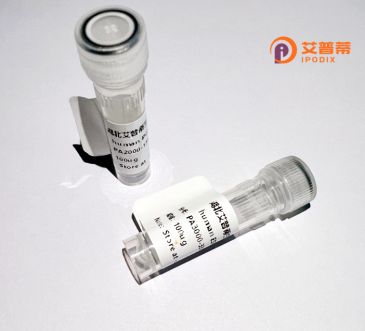
| 纯度 | >90%SDS-PAGE. |
| 种属 | Human |
| 靶点 | ATG13 |
| Uniprot No | O75143 |
| 内毒素 | < 0.01EU/μg |
| 表达宿主 | E.coli |
| 表达区间 | 1-517aa |
| 氨基酸序列 | METDLNSQDR KDLDKFIKFF ALKTVQVIVQ ARLGEKICTR SSSSPTGSDW FNLAIKDIPE VTHEAKKALA GQLPAVGRSM CVEISLKTSE GDSMELEIWC LEMNEKCDKE IKVSYTVYNR LSLLLKSLLA ITRVTPAYRL SRKQGHEYVI LYRIYFGEVQ LSGLGEGFQT VRVGTVGTPV GTITLSCAYR INLAFMSTRQ FERTPPIMGI IIDHFVDRPY PSSSPMHPCN YRTAGEDTGV IYPSVEDSQE VCTTSFSTSP PSQLSSSRLS YQPAALGVGS ADLAYPVVFA AGLNATHPHQ LMVPGKEGGV PLAPNQPVHG TQADQERLAT CTPSDRTHCA ATPSSSEDTE TVSNSSEGRA SPHDVLETIF VRKVGAFVNK PINQVTLTSL DIPFAMFAPK NLELEDTDPM VNPPDSPETE SPLQGSLHSD GSSGGSSGNT HDDFVMIDFK PAFSKDDILP MDLGTFYREF QNPPQLSSLS IDIGAQSMAE DLDSLPEKLA VHEKNVREFD AFVETLQ |
| 分子量 | 56.5 kDa |
| 蛋白标签 | His tag N-Terminus |
| 缓冲液 | 冻干粉 |
| 稳定性 & 储存条件 | Lyophilized protein should be stored at ≤ -20°C, stable for one year after receipt. Reconstituted protein solution can be stored at 2-8°C for 2-7 days. Aliquots of reconstituted samples are stable at ≤ -20°C for 3 months. |
| 复溶 | Always centrifuge tubes before opening.Do not mix by vortex or pipetting. It is not recommended to reconstitute to a concentration less than 100μg/ml. Dissolve the lyophilized protein in distilled water. Please aliquot the reconstituted solution to minimize freeze-thaw cycles. |
1. **《Structure of the Human Atg13-Atg101 HORMA Dimer Provides Insights into Interaction with ULK1》**
作者:Suzuki H, et al.
摘要:利用冷冻电镜解析人源ATG13-ATG101复合体的结构,揭示其通过HORMA结构域介导与ULK1激酶的互作机制,为自噬启动复合体的组装提供结构基础。
2. **《Phosphorylation of ATG13 regulates autophagy by controlling ULK1 kinase activity》**
作者:Papinski D, et al.
摘要:研究证实哺乳动物ATG13的磷酸化状态(如AMPK/mTORC1介导)动态调控ULK1激酶活性,阐明营养条件变化下自噬起始的核心信号通路。
3. **《ATG13 recruits STX17 to mediate ER-phagy under nutrient stress》**
作者:Kishi-Itakura C, et al.
摘要:发现ATG13在氨基酸缺乏时直接结合SNARE蛋白STX17.驱动内质网特异性自噬(ER-phagy),拓展了ATG13在细胞器质量控制中的新功能。
4. **《Quantitative proteomics identifies ATG13 as a critical mediator of basal and stress-induced autophagy》**
作者:Park JM, et al.
摘要:通过蛋白质组学分析揭示ATG13在不同应激(如缺氧、氧化损伤)下的表达动态及复合体稳定性,提出其作为自噬活性的生物标志物潜力。
Autophagy-related protein 13 (ATG13) is a critical component in the initiation of autophagy, a conserved cellular process responsible for degrading and recycling cytoplasmic components. In humans, ATG13 interacts with ULK1 (Unc-51-like kinase 1), FIP200. and ATG101 to form the ULK1 complex, which acts as a central regulatory node in autophagy induction. Under nutrient-rich conditions, mechanistic target of rapamycin (mTOR) phosphorylates ATG13 and ULK1. inhibiting their activity. During starvation or stress, mTOR inactivation triggers dephosphorylation of ATG13. enabling ULK1 kinase activation and subsequent recruitment of downstream autophagy machinery to form phagophores—the precursors to autophagosomes. Structurally, ATG13 contains intrinsically disordered regions that facilitate dynamic interactions within the ULK1 complex and promote phase separation, essential for autophagosome formation.
Recombinant human ATG13 (rhATG13) is produced via heterologous expression systems (e.g., *E. coli* or mammalian cells) for biochemical and cell-based studies. It enables in vitro reconstitution of ULK1 complex activity, phosphorylation assays, and exploration of autophagy signaling pathways. Dysregulation of ATG13 is implicated in diseases like cancer, neurodegeneration, and metabolic disorders, making its recombinant form a valuable tool for therapeutic research. Studies using rhATG13 have elucidated structural-mechanistic insights into autophagy initiation and its modulation by cellular energy status or pharmacological agents.
×